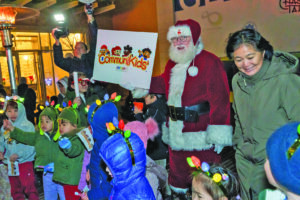
by Matt Delaney
New ideas were inoculating minds, broadening the array of possibilities and sparking conversations between parents, city residents and students alike over what the future holds for the community and Earth as we know it.
This was the scene at Falls Church City Public Schools’ “Schools of the Future” forum that took place at Mary Ellen Henderson Middle School last Saturday and focused on green initiatives in and out of the classroom that were coming to Falls Church with the prospective renovations to or the rebuilding of George Mason High School.
The stars of the forum were five panelists Falls Church Schools brought on to lead the discussion about the school system’s directive to invigorate the look and structure of the classroom: Michael Mondshine, WSP|Parsons Brinkerhoff, Vice President, Sustainability and Energy; Josh Lasky, Center for Green Schools at the U.S. Green Building Council; Doug Gehley, VMDO Architects; Bruce Beddow, project manager, EMX Corporation; and George Mason High principal Tyrone Byrd.
Gehley discussed how absurd it is to prepare students for success with outdated resources and archaic lecture-based classes in this day and age. He called for 360 degree learning, not just in the classroom, but throughout the building, represented by factoids painted on stairwells and immersive hallways crafted around geographical elements like canopies, making the atmosphere comfortable and accessible as well as interesting and fun.
Byrd followed up with how George Mason was already taking steps to improve teaching methods, with some teachers employing the school system’s abundance of new technology. He informed the crowd that students and teachers are both pushing classroom environments to new heights with their educational ambitions.
“What’s going to drive this mission and this development forward is how it impacts education,” Byrd said. “This community has been built on a foundation of strong educational component for our kids. [That’s why Falls Church City Schools] broke itself away [from Fairfax County Public Schools]…to ensure all of our kids got a world-class education.”

Lasky addressed the goal to reduce net impact on the environment while improving health and performance of students and teachers and highlighted that the challenge is not showing initial interest, but staying involved once the physical project is complete.
Logistics were covered by Beddow, who talked about locations of geothermal wells and the layout of roof-based solar panels, and how it’s necessary to plan for energy requirements in advance, not for today’s standards.
Mondshine rounded out the panel with a discussion on district energy systems, which channel energy that is typically wasted back into productive uses for the project at hand.
The panelists were assuredly honed-in on the fact this project is about education, not the glamorization of the school and community. However those who attended seemed to have different intentions in mind, indicated by the residents’ inquisitive nature over the functioning of the school in the Q&A session. Though, as one panelist expressed, this is a natural part of the process.
“In any development project, especially a mixed-use project like this with a significant piece of land, the focus is rightfully on the biggest area of investment, financially, which is going to be the design of the space and use of the land,” Lasky said. “I don’t think that’s a cause for concern, but that’s why we’re having conversations like this so we…[are] not just thinking about energy or water or waste in singular categories, but connecting them together and trying to optimize all that for the benefit of the students.”
During the final part of the forum the attendees formed small groups and listed what they felt the principal focus of the project should be moving forward. The groups, a nod to reformed teaching techniques the schools and the panel are a proponent of, showcased that the environmental footprint is something to be cognizant about, but education supersedes all other objectives.
“I have three kids; I see the way they learn best,” Mondshine said. “They don’t learn best when they’re sitting at a desk and having someone talk at them, they learn best when they’re living it, learning it, touching and feeling it.”
The project began with a cafeteria full of city residents who were ready to learn about the new frontiers Falls Church City Schools were crossing in to.
“The turnout was remarkable,” Mondshine said. “It’s inspiring that people are so engaged and, because none of us are as smart as all of us, it makes a big difference in the ultimate outcome.”












